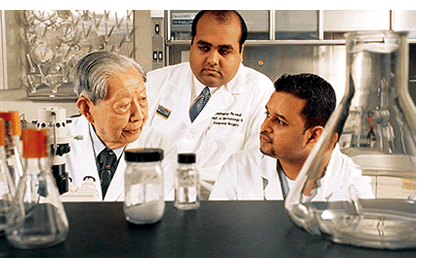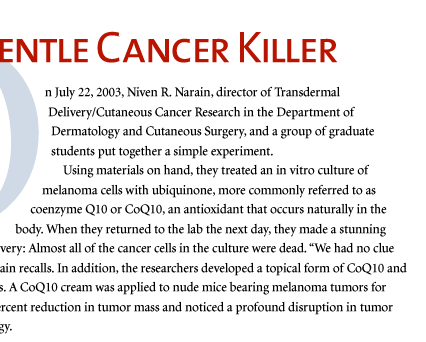 |
 |
|
 |
Because the results were
so striking, the researchers thought perhaps something was wrong with
their protocol, which they repeated carefully over and over again. They
received the same results. In laboratory and animal studies, the UM researchers
found that by delivering CoQ10 to cancer cells and tissues, the molecule
induced apoptosis, which is the normal programmed cell death that goes
awry in the disease process.
This was not the first time that Narain and the other research associates had noticed that this application of CoQ10 could kill cancer cells, but it was hard to imagine that CoQ10, a benign and natural force in the body, would be harming anything. S. L. Hsia, Ph.D., director of the Transdermal Delivery/Cutaneous Biology Laboratory and principal investigator of the research, had been working with ubiquinone for years and created the phospholipid base that enabled the substance to penetrate the cells. “We’d go to Dr. Hsia and say, ‘You know, these cells are dying,’ and he’d say, ‘What is the mechanism then? How can it kill cancer?’” says Narain.
CoQ10 is one of the most important antioxidants found in the body and is used by cells not only to protect against free radical damage but also to produce ATP, a compound that powers every cell in the human body. High levels of CoQ10 are especially essential in the high-activity cells, such as heart muscle cells, brain cells, and immune system cells. As we age, CoQ10 levels drop off, and decreased levels of the antioxidant have been observed in cancer, diabetes, and neurodegenerative diseases.
CoQ10 was discovered by University of Wisconsin researcher Fred Crane, M.D., in 1957, but it’s only in the last two decades that the antioxidant began to be used in the treatment of disease. Since 1987, researchers have been focusing on the application of CoQ10 for muscular fatigue, joint pain, cardiomyopathy, and Parkinson’s disease. But the research team in the Miller School of Medicine’s Department of Dermatology is the first to “elucidate a specific cellular mechanism for CoQ10 that’s involved in cancer,” says Narain.
“Given that CoQ10 is resident in the mitochondria, and the mitochondria plays a very crucial role in the cell, I think as time goes on and people do more investigation into CoQ10, we are going to see new and novel roles for its physiology. It’s like a huge onion. And as we continue to unravel that onion, we find in one layer, there’s an antioxidant effect. We continue to unravel, and then we find a weapon against cancer. As we keep going, we may find more and more uses,” says Narain.
One of the most striking findings about the CoQ10 studies is how gentle and nontoxic the therapy appears to be: “There is no evident side effect per se to taking CoQ10,” Narain says.
“It is amazing that a benign compound, CoQ10, can cause the cancer cells to selectively kill themselves without harm to normal cells,” Hsia says. “Moreover, we have a novel topical delivery system that offers cancer patients an improved quality of life with a boost of energy. Indeed, our team looks forward to one day bringing the benefit and hope of this technology to many cancer patients.”
The scientists presented their findings at two meetings this spring. The first presentation involved the most common prostate cancer cell line, PC3. The researchers showed that by adding CoQ10 to the cells in vitro or in the laboratory, there was a 70 percent inhibition of cell growth over 48 hours and a reversal in the expression of a key anti-apoptotic protein, bcl-2. In the second presentation, the researchers showed the impact of CoQ10 on several different breast cancer cell lines. They found the substance greatly inhibited the proliferation of breast cancer cells while providing a stabilizing effect on the normal mammary cells. “This suggests to us that CoQ10 could be an effective adjuvant anti-tumor agent in breast carcinomas,” says Indushekhar Persaud, chief bioengineer for drug delivery therapeutics in the Department of Dermatology and Cutaneous Surgery.
The scientists have employed various ways to deliver the CoQ10, including through the skin. They used liposomes made of phospholipids as a molecular vehicle to deliver dermatologically active agents into targeted cells. “This significant work is an excellent model for the important outcomes of basic science research to offer new opportunities for exploring therapeutic options in ill patients. It is the laboratory bench-to-bedside paradigm we all seek,” says Lawrence Schachner, M.D., chairman of the Department of Dermatology.
The many benefits of CoQ10 are still being uncovered—including a clinical trial with the UM football team testing CoQ10 for muscle fatigue and joint pain. “I don’t think this is the cure-all, end-all molecule,” says Narain. “But it’s certainly a good one.”